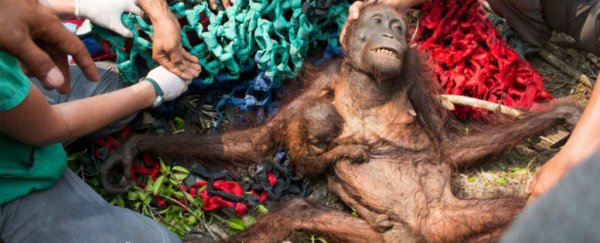For the past few months, fires have raged on the southeast Asian islands of Sumatra and Borneo. They also happen to be the two islands that house the remaining 50,000 orangutans in the wild, and new estimates from conservationists suggest that one-third of them are now in danger of being wiped out by the blaze.
Orangutans are already threatened by the steady expansion of palm-oil plantations, not to mention hunting and pet trading. But now harrowing images have emerged of the apes fleeing the flames, covered in burns, and suffering from smoke inhalation. The photo above went viral on social media today, showing a mother and baby being attacked by frightened locals after they ran into a village to escape the fire.
Thankfully, the mother and baby were rescued by International Animal Rescue and are now recovering in a safe place. But it puts a very real face on exactly what has been going on for months in Indonesia.
"Over half the world's orangutans live in peat-swamp forests, and every one of these peatlands in Borneo right now is on fire, somewhere," Simon Husson, one of the directors of the UK-based Orangutan Tropical Peatland project, told Scientific American.
So how did the fires get so bad? It's not unusual for Indonesia to experience wildfires during the dry season, but due to a powerful El Nino season, the fires have spread into national parks and primary forests, which are among the last refuges for not only orangutans but also other endangered species such as rhinoceros and tigers.
"I dread to think what it will mean for orangutans. For them and other species, like the secretive clouded leopard and the iconic hornbill, the situation is dire and deteriorating by the day," Mark Harrison, another director of the Orangutan Tropical Peatland Project, told The Guardian.
So far more than 100,000 fires have burnt 2 million hectares of forest throughout Sumatra and the Indonesian half of Borneo. Researchers and fire fighters have been working since late this summer to control and track the blazes, as well as monitor and help orangutans.
But due to poor land management practices, and the amount of natural ecosystem that has been cut down and replaced with palm oil plantations, it's proved impossible to stop the burning.
"In their undisturbed, flooded state, peatland forests are naturally fire-resistant. But decades of poor peatland management practices, including extensive forest clearance and canal construction, has drained the peat, putting the whole region at high fire risk when the inevitable droughts occur," said Harrison.
 Bjorn Vaughn via Centre for Great Apes
Bjorn Vaughn via Centre for Great Apes
Unfortunately, it's not only animals are in danger. The smoke emitted by the wildfires has shut down Indonesian airports, and around 50,000 cases of respiratory infections have been caused by the blaze. Six Indonesian provinces have declared a state of emergency.
Even more worrying is the impact that these fires are having on the environment. Peatfires are significant carbon stores in their natural state, but when burnt, they emit up to 10 times the methane of regular wildfires.
In fact, data has revealed that the emissions generated every day from the Indonesian fires exceed the daily emissions of the entire US economy. Within just three weeks, the fires had exceeded the total annual CO2 emissions of Germany.
Meanwhile on the other side of the world in Paris, the world's leaders prepare to talk about the future of climate change. And we sincerely hope that putting these fires out will be at the top of the agenda, if only for the planet's sake.
As Erik Meijaard, coordinator of the Borneo Futures initiative, wrote for the Jakarta Globe: "I think what might help to garner action both locally and globally is to call this year's fire and haze disaster what it really is: the biggest environmental crime of the 21st century."
